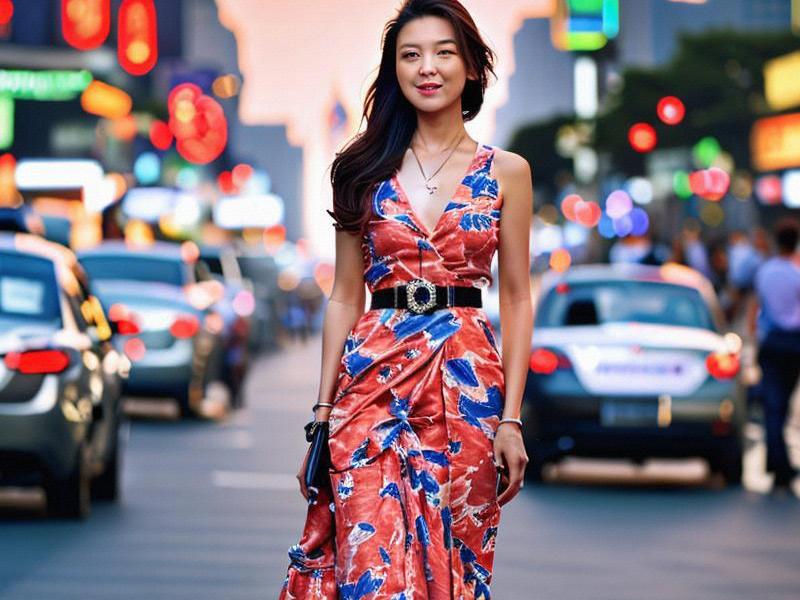
Shanghai, a city that has long been synonymous with elegance and sophistication, has a rich history of "Shanghai Beauties." These women, often depicted as the epitome of grace and charm, have played a significant role in shaping the city's identity and cultural landscape. From the early 20th century to the present day, the image of the Shanghai beauty has evolved, reflecting the changing times and societal values.
In the early 1900s, Shanghai was known as the "Paris of the East," a cosmopolitan hub where Eastern and Western cultures交融融合 (fused/fused together) (fused). During this period, the concept of the Shanghai beauty emerged, characterized by a unique blend of traditional Chinese aesthetics and Western fashion trends. These women were often seen as symbols of modernity and progress, embodying the spirit of the city's rapid transformation.
One of the most iconic figures of this era was the "Glamorous Lady" (摩登女郎) (modern lady), a term used to describe women who embraced Western fashion and lifestyle. They were often portrayed in films, literature, and advertisements, showcasing their impeccable style and confidence. The glamorous ladies of Shanghai not only set fashion trends but also challenged traditional gender roles, paving the way for greater social mobility and independence for women.
As Shanghai continued to grow and modernize, the image of the Shanghai beauty evolved. In the mid-20th century, the city became a center for the film industry, producing countless stars who became national icons. Actresses like 周璇 (Zhou Xuan), 袁美云 (Yuan Meiyun), and 上官云珠 (Shangguan Yunzhu) captured the hearts of audiences with their talent and beauty. These stars not only graced the silver screen but also influenced fashion and beauty standards, becoming role models for generations of women.
上海龙凤419是哪里的 The 1930s and 1940s were particularly significant for the Shanghai beauty, as the city was at the height of its prosperity. The influx of Western culture and the rise of the entertainment industry created a vibrant and dynamic environment. Women during this time were expected to be well-dressed, well-spoken, and confident, embodying the ideals of modernity and sophistication.
However, the image of the Shanghai beauty was not without its challenges. The city's rapid modernization and exposure to Western influences also brought about societal pressures and expectations. Women were often judged by their appearance and social status, leading to a culture of competition and comparison. Despite these challenges, the Shanghai beauty remained a symbol of resilience and adaptability, navigating the complexities of a changing world.
In the latter half of the 20th century, Shanghai underwent significant political and economic changes, which influenced the image of the Shanghai beauty. During the Cultural Revolution, traditional beauty standards were de-emphasized, and the focus shifted to political loyalty and ideological purity. The glamorous ladies of the past were replaced by figures who embodied the revolutionary spirit, and the concept of beauty became more utilitarian.
However, with the economic reforms and opening up of China in the late 1970s, Shanghai began to regain its status as a global city. The image of the Shanghai beauty experienced a resurgence, blending traditional Chinese elements with modern Western influences. This new generation of beauties was characterized by their confidence, independence, and global outlook, reflecting the city's renaissance.
上海龙凤419官网 Today, the Shanghai beauty continues to evolve, embodying the spirit of a dynamic and cosmopolitan city. Modern Shanghai women are known for their fashion sense, career ambitions, and social awareness. They are not only trendsetters in the fashion world but also leaders in various fields, including business, technology, and the arts.
The influence of Shanghai beauties extends beyond the city, shaping beauty standards and cultural trends across China and beyond. The city's fashion industry, with its blend of traditional and modern styles, has become a global powerhouse, attracting designers, models, and fashion enthusiasts from around the world. Shanghai's beauty scene is a testament to the city's ability to embrace diversity and innovation, creating a unique identity that resonates with people from all walks of life.
In addition to their fashion and beauty, Shanghai beauties are known for their cultural sophistication and intellectual curiosity. The city's rich history and vibrant arts scene provide a fertile ground for creativity and self-expression. From traditional Chinese opera to contemporary art exhibitions, Shanghai offers a wide range of cultural experiences that inspire and enrich the lives of its residents.
上海贵人论坛 The concept of the Shanghai beauty is not limited to physical appearance but also encompasses a sense of grace, intelligence, and confidence. These qualities are reflected in the city's women, who are known for their ability to navigate the complexities of modern life with poise and elegance. Whether in the boardroom, the fashion runway, or the art gallery, Shanghai beauties continue to make their mark, embodying the spirit of a city that is both traditional and modern.
As Shanghai continues to grow and evolve, the image of the Shanghai beauty will undoubtedly adapt to reflect the changing times. However, one thing remains constant: the Shanghai beauty is a symbol of elegance, resilience, and innovation, representing the best of what this remarkable city has to offer.
In conclusion, the journey through the world of Shanghai beauties is a fascinating exploration of the city's cultural heritage and modern identity. From the glamorous ladies of the early 20th century to the confident and accomplished women of today, the Shanghai beauty has always been a reflection of the city's spirit. As Shanghai continues to thrive as a global hub, the image of the Shanghai beauty will remain a source of inspiration and pride, embodying the city's unique blend of tradition and modernity.
